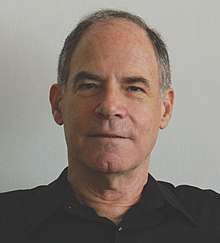Moshe Goldberg
Moshe Goldberg (Hebrew: משה גולדברג) (born 1945) is an Israeli mathematician.
Moshe Goldberg | |
|---|---|
 Moshe Goldberg | |
| Born | March 23, 1945 |
| Nationality | Israeli |
| Children | Maya (born 1975) |
| Alma mater | Tel Aviv University |
| Scientific career | |
| Fields | Mathematics, Applied Mathematics |
| Institutions | UCLA (1974–1979), Technion – Israel Institute of Technology (1979–present) |
Early life
Goldberg was born and grew up in Tel Aviv. His parents, Gad Goldberg, born in Lublin (Poland) and Rachel Raya (née Farber), born in Vilnius (Lithuania), immigrated to Palestine shortly after Hitler became Germany's chancellor in 1933.
Career
After completing his undergraduate studies, Goldberg served in the Israel Defense Forces for three years. Released at the rank of captain, he resumed his studies, earning his Ph.D. from Tel Aviv University in 1973 under the supervision of Saul Abarbanel.[1] After a postdoctoral position at the University of California, Los Angeles (UCLA), he joined the Technion – Israel Institute of Technology in 1979, and in due course became the Ruth and Samuel Jaffe Professor of Mathematics. In 2013 he retired as Professor Emeritus.[2]
Research
Goldberg has published over 80 research papers[3][4] and given over 100 talks at international conferences. His co-authors include Richard F. Arens, Michael Cwikel, Robert Guralnick, Thomas J. Laffey, W. A. J. Luxemburg, Ernst G. Straus, and Eitan Tadmor.[4] His visits to some of the world's leading universities have included sabbaticals at UCLA, California Institute of Technology (Caltech), and Université Paris Dauphine (Paris 9). He has served on over 20 editorial boards of mathematical journals and on numerous national and international professional committees.[5]
Goldberg began his scientific career by studying computational fluid mechanics. He then turned to a variety of other topics, including finite-difference approximations to hyperbolic and parabolic partial differential systems, linear and Multilinear algebra, matrix and operator theory, functional analysis, and various types of algebras.[4]
A substantial part of his work has focused on various aspects of norms, seminorms, and subnorms. One such project deals with a natural extension of the classical spectral radius to finite-dimensional power-associative algebras. This study, which encompasses the Cayley–Dickson algebras, is relevant to stability of norms and subnorms, and to the well-known Gelfand formula.[6]
Selected publications
- S. Abarbanel and M. Goldberg, Numerical solution of quasi-conservative hyperbolic systems—The cylindrical shock problem, Journal of Computational Physics, Vol. 10, No. 1 (1972), pp. 1–21.
- S. Abarbanel and M. Goldberg, Stable approximations for hyperbolic systems with moving internal boundary conditions, Mathematics of Computation, Vol. 28, No. 126 (1974), pp. 413–447.
- M. Goldberg and E. G. Straus, Elementary inclusion relations for generalized numerical ranges, Linear Algebra and Its Applications, Vol. 18, No. 1 (1977), pp. 1–24.
- M. Goldberg and E. G. Straus, Norm properties of C-numerical radii, Linear Algebra and Its Applications, Vol. 24 (1979), pp. 113–131.
- M. Goldberg and E. Tadmor, On the numerical radius and its applications, Linear Algebra and Its Applications, Vol. 42 (1982), pp. 263–284.
- M. Goldberg, Ernst G. Straus (1922–1983), Linear Algebra and Its Applications, Vol. 64 (1985) pp. 1–19.
- M. Goldberg and E. Tadmor, Convenient stability criteria for difference approximations of hyperbolic initial-boundary value problems. II, Mathematics of Computation, Vol. 48, No. 178 (1987), pp. 503–520.
- R. Arens and M. Goldberg, A class of seminorms on function algebras, Journal of Mathematical Analysis and Applications, Vol. 162, No. 2 (1991), pp. 592–609.
- R. Arens and M. Goldberg, Quadrative seminorms and Jordan structures on Algebras, Linear Algebra and Its Applications, Vol. 181 (1993), pp. 269–278.
- R. Arens, M. Goldberg and W. A. J. Luxemburg, Multiplicativity factors for Orlicz space function norms, Journal of Mathematical Analysis and Applications, Vol. 177, No. 2 (1993), pp. 386–411.
- R. Arens and M. Goldberg, Jordan-multiplicative norms, Linear and Multilinear Algebra, Vol. 41, No. 1 (1996), pp. 9–18.
- M. Goldberg, Stable difference schemes for parabolic systems—A numerical radius approach II, SIAM Journal on Numerical Analysis, Vol. 35, No. 5 (1998), pp. 1995–2003.
- M. Goldberg, R. Guralnick and W. A. J. Luxemburg, Not all quadrative norms are strongly stable, Indagationes Mathematicae (N.S.), Vol. 12, No. 4 (2001), pp. 469–476.
- M. Goldberg and A. Pidgirnyak, Stability criteria for finite difference approximations to parabolic systems—an update, Journal of Scientific Computing, Vol. 17, No. 1–4 (2002), pp. 423–435.
- M. Goldberg, R. Guralnick and W. A. J. Luxemburg, Stable subnorms II, Linear and Multilinear Algebra, Vol. 51, No. 2 (2003), pp. 209–219.
- M. Goldberg, Stable norms—from theory to applications and back, Linear Algebra and Its Applications, Vol. 404 (2005), pp. 223250.
- M. Goldberg, Minimal polynomials and radii of elements in finite-dimensional power-associative algebras, Transactions of the American Mathematical Society, Vol. 359, No. 8 (2007), pp. 4055–4072.
- M. Cwikel and M. Goldberg, Homotonic algebras, Studia Mathematica, Vol. 195, No. 3 (2009), pp. 287–295.
- M. Goldberg and T. J. Laffey, On the radius in Cayley–Dickson Algebras, Proceedings of the American Mathematical Society, Vol. 143, No. 11 (2015), pp. 4733–4744.
- J. Chmieliński and M. Goldberg, Continuity and discontinuity of seminorms on infinite-dimensionnal vector spaces. II, Linear Algebra and Its Applications, Vol. 594 (2020), pp. 249–261.
References
- "Moshe Goldberg". Mathematics Genealogy Project. Retrieved 23 July 2019.
- "Moshe Goldberg". Technion – Israel Institute of Technology. Retrieved 23 July 2019.
- "Moshe Goldberg, list of publications". American Mathematical Society, MathSciNet. Retrieved 23 July 2019.
- "Moshe Goldberg, Co-authors and areas of research". American Mathematical Society, MathSciNet. Retrieved 23 July 2019.
- "A short biography of Moshe Goldberg" (PDF). Linear Algebra and Its Applications, Vol. 438, issue 10, pp. 3735–3738. Retrieved 23 July 2019.
- See items 17 and 19 in selected publications.